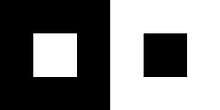Irradiation illusion

| Look up irradiation in Wiktionary, the free dictionary. |
The irradiation illusion is an illusion of visual perception in which a light area of the visual field looks larger than an otherwise identical dark area. It was named by Hermann von Helmholtz around 1867;[1] but the illusion was familiar to scientists long before then; Galileo mentions it in his Dialogue Concerning the Two Chief World Systems.[2] It arises partly from scattering of light inside the eye. This has the effect of enlarging the image of a light area on the retina.
References
This article is issued from Wikipedia - version of the 11/9/2014. The text is available under the Creative Commons Attribution/Share Alike but additional terms may apply for the media files.